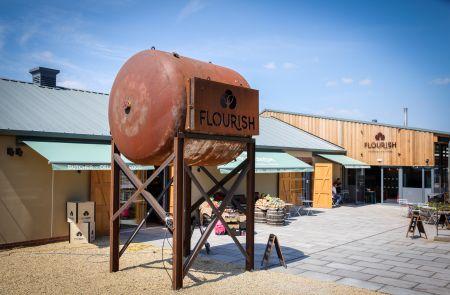In case you missed it see what’s in this section
Let's Talk
Why More Companies Are Choosing Used Shipping Containers to Save Costs
Walk past a construction site in Manchester, a festival field in Dorset, or even Bristol’s bustling Wapping Wharf, and you’ll notice a familiar shape: steel shipping containers repurposed for business. Some sit stacked and painted, forming pop-up cafés or studios. Others remain plain grey, used as secure on-site storage. What connects them is cost.
For small and mid-sized companies, used shipping containers have become a budget-friendly alternative to expensive leases and new builds. They’re durable, they arrive ready to use, and they cost a fraction of permanent structures. In a climate where overheads eat into margins, these steel workhorses are proving their worth on land just as much as at sea.
Key Takeaways Why Used Containers Make Business Sense
- Used containers can cost 4060% less than new ones.
- Setup is fast: from delivery to use in a matter of days.
- Containers last 15-20 years with basic maintenance.
- Modular design allows units to be stacked, relocated, or expanded.
- Companies avoid recurring rent, freeing capital for growth.
- Repurposing containers supports sustainability and CSR targets.
What Are Used Shipping Containers and Why Are They in Demand?
What Counts as “Used”?
When containers leave shipping fleets, they’re often sold on to secondary markets. While they may carry dents, faded paint, or minor surface rust, their steel build makes them resilient. Before resale, containers are graded:
- Wind and water-tight (WWT): secure for storage.
- Cargo-worthy: fit for continued transport use.
- Refurbished: cleaned, repaired, and sometimes repainted.
Standard sizes are 20ft and 40ft, though high-cube models (taller at 9’6”) and refrigerated units exist.
Rising Demand Across Industries
The demand isn’t limited to quirky retail projects. Construction firms use them for secure tool storage. Farmers rely on them for grain and equipment. Universities fit them out as temporary classrooms or labs.
In London, projects like Boxpark turned containers into modular shopping hubs, showing how flexible they could be. Beyond retail, logistics and manufacturing companies increasingly choose used containers as a way to control storage costs in volatile property markets.
Core Cost-Saving Advantages of Used Shipping Containers
Lower Upfront Cost
A new 20ft container can cost between £5,000 - £8,000. Used versions are typically £2,000- £3,500. A company buying ten units could save upwards of £40,000 immediately.
Compare this with warehouse leasing. In Birmingham, industrial rents average £60£80 per square metre per year. A 5,000 sq ft lease could run £250,000 over five years. Ten used 40ft containers delivering similar storage capacity might cost just £30,000-£35,000 as a one-off purchase.
Reduced Construction Time and Labour
Unlike traditional buildings, containers arrive as complete shells. They need little more than placement and basic site prep. For offices or workshops, conversions can take weeks instead of months, slashing labour costs.
This is particularly attractive for construction contractors setting up temporary offices or storage on job sites where speed directly affects project costs.
Durability and Low Maintenance
Made from Corten steel, shipping containers are built to endure salt air, storms, and heavy handling. Even after years at sea, they can provide 15-20 years of service on land. Maintenance typically involves repainting, sealing minor rust patches, and ensuring door gaskets remain tight.
Modular, Scalable, and Mobile
Because containers follow standard dimensions, they can be stacked, joined, or relocated easily. A business needing extra space can add units as required. If the company moves, containers move with them — something fixed warehouses or offices can’t offer.
Most Popular Business Use Cases
On-Site Storage Solutions
Construction companies often deploy containers to hold tools, equipment, or building materials. Retailers use them as seasonal storage to free up shop floor space during peak trading periods.
Temporary or Semi-Permanent Offices
From oilfields to university campuses, containers are converted into functional offices, labs, and classrooms. The appeal lies in affordability and mobility — they can be moved between sites as needs change.
Retail and Hospitality Pop-Ups
Boxpark in Shoreditch may be the most famous example, but similar projects now appear across the UK. Cafés, bars, and seasonal shops use containers because they’re cost-effective and can be set up in high-traffic areas without major construction.
Workshops and Makerspaces
Startups, artists, and small manufacturers benefit from containers as affordable workshops. With basic modifications, insulation, electrical wiring, ventilation a used container can become a safe, enclosed space for production or creative work.
Environmental and Sustainability Benefits
Supporting CSR Goals
Each reused container prevents several tonnes of steel from being scrapped and reduces demand for energy-intensive new construction. Businesses gain an affordable way to align with sustainability commitments.
ESG and LEED Credits
Repurposed containers can help projects earn LEED credits and strengthen ESG reporting. With regulatory and investor scrutiny increasing, this benefit adds weight to the financial case.
What to Check Before Buying
Inspection Checklist
- Look for rust, dents, or structural damage.
- Inspect flooring for contamination from past cargo.
- Test doors and seals for water resistance.
- Verify certification (CSC plate if the unit may be shipped).
Modification Costs
Basic storage needs little alteration, but offices and workshops require insulation, plumbing, HVAC, and electrical work. Budgeting for modifications is key to calculating ROI.
Zoning and Permits
Rules vary. Some councils treat containers as temporary structures; others require permits for long-term placement. Early checks avoid costly mistakes.
Where to Source Used Containers
Reputable Sellers and Marketplaces
Containers are available through suppliers, yards, and online platforms like BoxHub or companies like Universal Containers. Businesses should request inspection reports and confirm supplier credentials.
Leasing vs. Purchasing
Leasing works for short-term projects or events, while purchasing is better for storage or permanent workspace. Cost comparisons over 35 years usually show ownership as more economical.
Long-Term ROI vs. Traditional Options
ROI Over 35 Years
- 10 used containers at £3,000 = £30,000 total.
- Equivalent warehouse lease = £30,000+ annually.
By year three, containers typically break even and then continue saving money.
Hidden Savings
Containers reduce relocation costs and minimise downtime during expansion, avoiding the hidden expenses often overlooked in construction projects.
Are Used Containers the Right Choice?
For some businesses, containers are a stopgap. For others, they’re a permanent part of expansion plans. Either way, the maths is hard to ignore: used containers are affordable, durable, and flexible.
As property prices rise and sustainability pressures mount, the steel boxes that once crossed oceans are finding new life on land. From secure storage to modular offices, they’re helping companies cut costs while staying agile.
Weather in Bristol
Listings
















